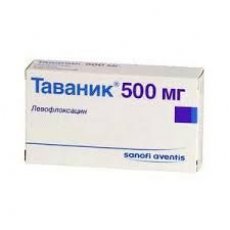Medical expert of the article
New publications
Preparations
Tavanic
Last reviewed: 03.07.2025

All iLive content is medically reviewed or fact checked to ensure as much factual accuracy as possible.
We have strict sourcing guidelines and only link to reputable media sites, academic research institutions and, whenever possible, medically peer reviewed studies. Note that the numbers in parentheses ([1], [2], etc.) are clickable links to these studies.
If you feel that any of our content is inaccurate, out-of-date, or otherwise questionable, please select it and press Ctrl + Enter.

The drug Tavanic belongs to the pharmacological group of fluoroquinolone antibacterial agents of the third generation. Other commercial names of the drug: Levofloxacin, Leflobact, Levaquin, Levolet, Glevo, Oftaquix, Tigeron, Flexid, Ecolevid, Eleflox.
Indications Tavanic
The high antimicrobial and antibacterial activity of the drug Tavanic determines its wide use in such inflammatory diseases of infectious etiology as:
- pneumonia, chronic bronchitis;
- acute otitis, sinusitis, sinusitis;
- abscesses (including abdominal and pelvic organs);
- furunculosis;
- infectious chronic prostatitis;
- acute cystitis, urethritis, pyelonephritis;
- chlamydia, mycoplasmosis;
- intestinal infections;
- tuberculosis.
Pharmacodynamics
The mechanism of antibacterial and antimicrobial therapeutic effect of the drug Tavanic is provided by the active substance of the drug - the fluoroquinolone derivative levofloxacin. This substance affects the cellular enzymes of bacteria and microbes. As a result, the synthesis of DNA and RNA is disrupted in the cells of pathogenic microorganisms, which causes morphological changes in the cytoplasm, membranes and cell walls and leads to their death.
Tavanic is active against beta-lactamase-producing gram-negative and gram-positive bacteria, as well as chlamydia, mycoplasma, Pseudomonas aeruginosa and Haemophilus influenzae, and enterobacteria.
Pharmacokinetics
The active substance of the drug Tavanic is quickly absorbed from the digestive tract after oral administration, bioavailability is 99%.
From 24 to 38% of the drug binds to blood plasma proteins and penetrates into tissues and organs; the maximum concentration in the blood is achieved after 80 minutes.
Metabolism of a small part of Tavanic occurs by deacetylation and oxidation in the liver. More than 85% of the administered dose of the drug is excreted unchanged in the urine, about 4% is excreted in the large intestine. The elimination period of the drug is 48-72 hours.
Dosing and administration
Tavanic solution is used for intravenous slow infusions in a hospital setting. The dosage is determined by the doctor based on the diagnosis and the patient's condition. The maximum duration of the infusion course is 14 days.
Tavanic tablets are taken orally, regardless of food intake, with water. The dose is determined individually, depending on the existing pathology. For example, when treating infectious inflammations of the urinary tract and ENT organs, one tablet (250 mg) is prescribed once or twice a day (for 10-14 days); for infectious chronic prostatitis - one tablet (500 mg) once a day (course of treatment - 28 days).
Use Tavanic during pregnancy
The use of Tavanic during pregnancy and breastfeeding is contraindicated.
Contraindications
Contraindications to the use of Tavanic are: increased individual sensitivity to drugs containing fluorine; age under 18; epilepsy.
Also, this drug is not used in cases where treatment with glucocorticosteroids is prescribed due to the risk of decreased tendon strength and rupture.
Side effects Tavanic
The use of Tavanic may be accompanied by side effects: headache or muscle pain, dizziness, weakness, sleep disturbance; nausea, vomiting, diarrhea, abdominal pain, dysbacteriosis; decreased blood pressure, a sharp drop in vascular tone, increased heart rate; increased appetite and sweating; tremor, movement disorders, sensory disturbances; muscle weakness and tendon rupture.
Possible side effects of Tavanic include acute renal failure, anemia, leukopenia, increased sensitivity of the body to UV radiation (photosensitivity), itching and redness of the skin, swelling of the mucous membranes, and suffocation.
There is also a risk of disruption of skin pigment metabolism and the development of severe myopathy with destruction of muscle tissue cells. The development of new infectious processes is not excluded.
 [ 23 ]
[ 23 ]
Interactions with other drugs
In case of using Tavanic simultaneously with antibiotics of the aminoglycoside group (Gentamicin, Kanamycin, etc.), beta-lactam antibiotics and the antiprotozoal drug metronidazole, a combined effect of all drugs is observed both in terms of therapeutic effect and in terms of the manifestation of their undesirable side effects.
When Tavanic is taken simultaneously with the bronchodilator drug Theophylline and non-steroidal anti-inflammatory drugs (NSAIDs), the likelihood of seizures increases.
Anti-heartburn medications containing magnesium, calcium and aluminum ions, as well as osmotic laxatives (Guttalax, Lactulose, Duphalac, Normase, etc.) reduce the activity of Tavanic, as they reduce the level of its absorption.
Attention!
To simplify the perception of information, this instruction for use of the drug "Tavanic" translated and presented in a special form on the basis of the official instructions for medical use of the drug. Before use read the annotation that came directly to medicines.
Description provided for informational purposes and is not a guide to self-healing. The need for this drug, the purpose of the treatment regimen, methods and dose of the drug is determined solely by the attending physician. Self-medication is dangerous for your health.

